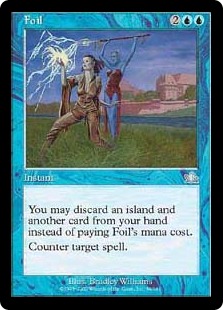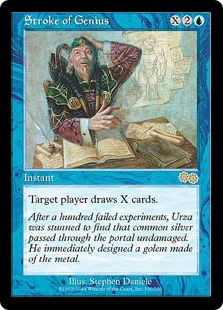Deck of the Week: Premodern Stasis
- Connor Kirkwood
- Apr 26, 2023
- 5 min read
Updated: Aug 23, 2023

Are you a blue mage?
Do you enjoy countering spells?
Do you enjoy stopping your opponents from playing Magic?
If you answered yes to all three of those questions, then I have great news for you! Premodern has a deck just for you! If you are known for being ‘the control player’ in your playgroup, Stasis should be your first choice when it comes to Premodern.

Stasis is a (mostly) blue control deck that revolves around the card ‘Stasis.’ The game plan is to get Stasis out as soon as possible, constricting your opponent’s mana and trapping cards in their hand. Even if they manage to play enough untapped lands to cast something, you will have a stockpile of counterspells to deal with it. Your opponent will no longer be able to play Magic while you continue to have fun!
How do we get around our own Stasis?
Once we have cast Stasis, we must pay one blue mana a turn to keep it on the battlefield. This can be a challenging task when we have to skip our untap step, but the deck is well-equipped to handle this.

The primary way we get around this is Forsaken City. Because of Stasis, neither player ends up playing a lot of spells. This means we will have plenty of cards in hand to exile to reliably untap Forsaken City every turn. This allows us to keep Stasis on the battlefield indefinitely, maintaining control over our opponents.
There are other ways around Stasis as well. Once we play a basic land and use it for mana, it will no longer untap. To get this land untapped, we can simply return it to our hand and replay it to use it for mana. There are a couple of cards that allow us to do this.

The first two cards that do this are both counterspells. Daze is a well-known counterspell widely used in Legacy but also has a lot of use in Premodern. Your opponent will be low on mana, so paying an extra one for their spell is pretty taxing on them. Daze taxes your opponent and allows you to return an island to your hand to replay on your next turn, gaining you extra mana overall.

The second counterspell is less well-known, but in this deck can be very powerful. Thwart has a similar mechanic to Daze, but instead of returning one island, it returns three. However, the additional cost allows you to straight-up counter your opponent’s spell. Returning three islands gains you more mana on future turns and can give you fodder for your Forsaken Cities.

The third card in this cycle excited me a lot. Restricted in Vintage and banned in Legacy and Pauper, Gush is an incredibly powerful spell. Tap down two of your islands to counter your opponent’s spell, and then return those two islands to your hand to draw two cards.
Gush digs you through your deck, gives you your Islands back to use, and provides you with extra cards to feed to your Forsaken City. I’m not a control player, but being able to play Gush is one of the things that makes me want to play this deck.
How else do we stop our opponents from having fun?
The main goal of this deck is to allow you to do things while stopping your opponent from doing things. Stasis is a great start. But what are other ways we can stop them from doing things?
This deck has 13 cards in the maindeck that say “Counter Target Spell.” Other than Daze and Thwart, Stasis also runs Counterspell, Foil, and Annul. There are an additional six counterspells included in the sideboard. It’s pretty easy to see that this deck’s main prerogative is to keep your opponent’s cards from resolving.

But what if your opponent’s spells resolve? There are plenty of backups for this scenario. Chain of Vapor is the easiest way to handle your opponent’s permanents. If they manage to sneak a Phantom Nishoba onto the battlefield, it really isn’t a problem for this deck. Simply Chain of Vapor it back to your opponent’s hand.
Most of the time, your opponent will have no reason to copy Chain of Vapor and send it back at you. Not only do they have to sacrifice a land, but most of the time, the only nonland permanent you have is Stasis. If you don’t have a good target for Chain of Vapor or you’ve run out of untapped lands, simply cast Chain of Vapor on your Stasis at the end of your opponent’s turn. On your turn, untap your lands and replay Stasis, giving your opponent no time to untap their own lands.
What if your opponent goes wide with their creatures, and you simply do not have enough Chain of Vapors to clear the board? First of all, Stasis also stops creatures from untapping, so most likely, your opponent’s creatures will only be able to attack you once. If you still have a problem, there is always Propaganda.

Propaganda is an OG card from Tempest and was the original Ghostly Prison. Causing your opponents to have to pay two mana for each attacking creature is a pretty hefty tax, considering their lands don’t untap. With Stasis and Propaganda on the battlefield, not only do their creatures not untap, but you have to tap lands to attack as well. This will provide you with the time you need to end the game.
How do we win?

There is really only one real wincon in this deck; three copies of Black Vise. The point of this deck is to leave cards stranded in your opponent’s hand, so what better way of killing them than to punish them for the number of cards in their hand?
The simple way of winning is just to wait out your opponent. Control the board, play Stasis, counter your opponent’s spell, and wait for Black Vise to kill your opponent. Once your opponent has seven cards in hand and is being bolted during each of their upkeeps, they usually die pretty quickly.
Need to kill your opponent a little faster? Stasis usually runs at least one Cunning Wish in the mainboard. You can use this to find a Stroke of Genius in your sideboard, which you can target your opponent with on your turn, drawing them a handful of cards. On their upkeep, they add up the number of cards in hand, subtract four, and usually die.

If Black Vise just won’t do it, this deck does have a backup mill plan. Cunning Wish can also search your sideboard for Brain Freeze. Late into the game, you can string together a series of Gushes, Impulses, and Chains of Vapor to rack up your Storm count and then mill the rest of your opponent’s deck with Brain Freeze.
Final Thoughts
I remember back when I played in the early 2000s, one of my brother’s favorite cards was Counterspell. We played hundreds of games together, and I can’t tell you the number of times that my favorite card was countered. It gradually built up an intense hatred for control in my mind, which lingers to this day.
While I am far from being a control player, I do respect this deck tremendously. Writing this article gave me flashbacks of what it was like playing against a mono-blue control deck back in the Premodern era of Magic. This deck has an excellent track record and has put up multiple first-place wins in recent months.
If you enjoy control decks in Modern, Pioneer, or Legacy, you are in for a treat. There are some games with this deck where your opponent doesn’t resolve a single spell. If they do manage to resolve a creature, it usually gets bounced back to their hand or sits on the battlefield. No, Premodern doesn’t have any Teferi or Jace Planeswalkers, but it does run Gush and all the OG counterspells, which easily make up for it.
It’s good that Force of Will is banned in Premodern, or this deck would be unbeatable.

You can find the decklist here.











Comments